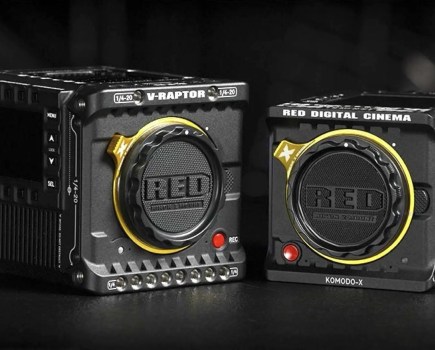There’s something about North Korea that fascinates us. Bookshelves strain under the weight of volumes written by political analysts, curious journalists and the few who have escaped the clutches of the country’s grip. We’ve also been fortunate to see a great number of images taken by some intrepid photojournalists such as Julia Leeb and Eric Lafforgue; the latter was recently banned from ever setting foot in the country again. But for one photographer, Michal Huniewicz, scenes from North Korea resonated with his upbringing.

Patiently waiting for the train to pass
Although Michal has lived in London for the past five years, he was born and raised in Dobrocin in Poland. He explains: ‘North Korea may seem like a distant nightmare to us in Europe, but not everywhere. Since Poland had a recent encounter with a totalitarian system, the madness of North Korea felt quite close to home. Animal Farm, 1984 and Fahrenheit 451 never felt much like works of fiction in Poland. Out of the four most recent generations of my family, I am the first one not to have been arrested by the Communists.’
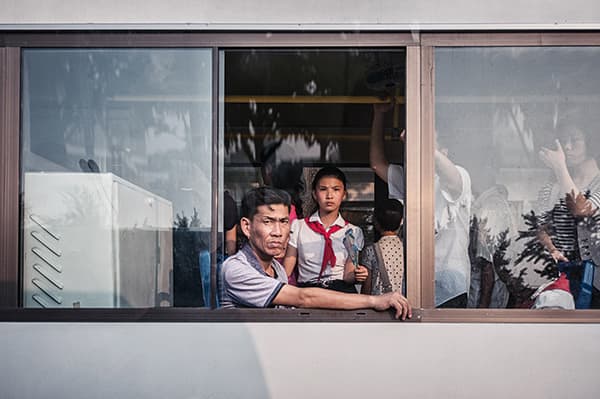
North Korean citizens commuting on the train
Journey to North Korea
Michal’s trip to North Korea lasted just four days and was tightly controlled from start to finish, with restrictions on how a tourist moves around the country indicative of the strict regime. ‘You can only go on an organised trip,’ Michal explains. ‘You can’t just show up at the border even if you have a visa. The Communist authorities must be aware and must approve of your visit. You get a visa for the exact days of the trip, and not a day more. Each attraction (be it a museum or a mausoleum – there isn’t much else) has to be separately signed off. If you’re American, it supposedly takes more paperwork on the North Korean side.’
There were seven tourists in Michal’s group, including his British friend and other visitors from Britain, New Zealand, Norway and the USA. Everybody on the trip took photographs, but nobody in the group was a professional. Despite what may be previously thought, photography itself is not banned in North Korea – in fact, it is positively encouraged, but of course under highly controlled conditions. As Michal points out: ‘They want you to take photos that show the country as normal and relatively affluent. We were endlessly shown the same skyscrapers, and the minivan we were in most of the time was driving slowly so you could take a sharp shot.’
Some subjects were on the no-shot list, though. ‘We were told that photos taken from the Dandong–Pyongyang train were not allowed,’ says Michal.
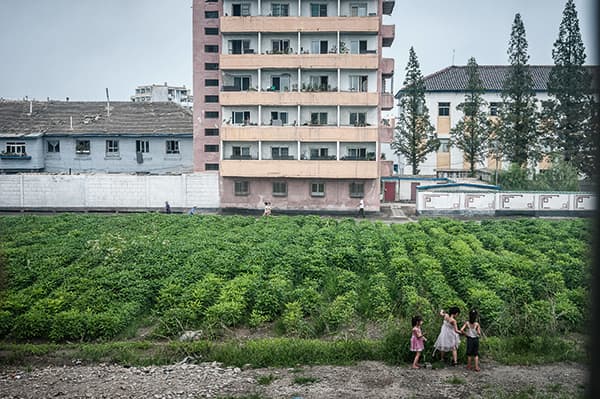
‘You’re not allowed to take pictures from the train,’ says Michal of this image taken in transit. ‘There are ordinary North Koreans on the train with you, but they didn’t say anything when I took these pictures. There are also uniformed North Koreans, and I avoided taking pictures when they were around. It was very much like a stealth video game. However, if they do catch you, they will probably just get upset and have you delete the photo’
‘Photos of soldiers were also not allowed, as were photos around 200km before the DMZ [Korean Demilitarised Zone]. Once in the DMZ, photography was allowed, but again not of soldiers – except for one designated soldier. You could take photos from the front and profile, but not of his back. Photos of the military installations are not allowed, nor from inside the Victorious War Museum – the war technically isn’t over yet.’
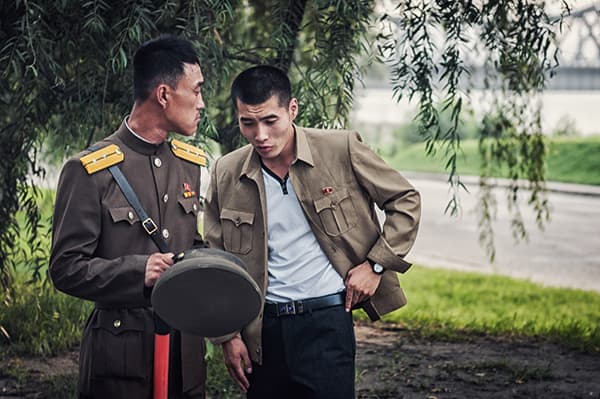
Two North Korean soldiers deep in conversation
Tourist groups are assigned guides who accompany you throughout your trip, keeping an eye on any banned or restricted behaviour. ‘Usually, we had one guide in front of us, and one in the back,’ says Michal. ‘They made a mistake at one point, and two or three of us managed to enter a shop that we were not allowed to enter. It was for local people only, and I took two sneak shots before we were kicked out. We were told our photos (both our cameras and photos) would be thoroughly searched, and should they find anything, we’d be detained. The guide took me aside, looked me in the eyes and said, “You took many pictures. Too many.” One day our guide said: “You’re not allowed to take photos here, so you will now go to sleep.” We had to go to sleep at 8am, right after breakfast.’
Michal believes it was fortuitous there was an American in the group. ‘They always keep an eye on you, but I was lucky to have an American in my group. He was my lightning rod – the guides were looking at him more than anyone else, so he had to be super careful, and I could take sneak shots. He had some of his photos deleted of the back of the soldier we were allowed to photograph.’
There were still some shots that Michal wasn’t able to get. ‘There were some slums in the outskirts of Pyongyang,’ he says. ‘Their very existence contradicts the North Korean narrative of the superiority of their system and their ways, so it would have been a thrill to photograph. But we only saw it briefly, and of course they wouldn’t stop the car for us to see – I managed only a blurry photo from afar.’

China borders North Korea on the Yalu River. In the city of Dandong, China, (pictured here) visitors who cannot obtain a visa can jump on a boat that sails past the country. For many this is their only taste of the city, particularly South Korean citizens
Hidden faces
Interactions with ordinary citizens of North Korea was a different experience than Michal is used to from his other travels. ‘Usually, they pretended they couldn’t see us,’ he says. ‘Everywhere around the world that I’ve been, regardless of cultural and language barriers, people are excited to see someone from abroad visiting. In North Korea, no such thing ever happened. They acted as if merely talking to us was a threat to them, which maybe it was. Occasionally, people would literally hide from the lens.’
Michal also believes that some scenes were actively staged for the cameras. ‘I couldn’t prove anything that we saw was fake, but many scenes looked highly unnatural,’ he adds. ‘We all know what a busy city looks like – it’s chaotic and loud, the opposite of Pyongyang. At one point, we were told that a spontaneous gathering had just taken place, where people on their way to work or elsewhere decided to join in a big dance, and we were lucky to be passing by. We stopped and were encouraged to take photos, so I captured women wearing ceremonial dresses, cars with large speakers playing music… it didn’t strike me as massively spontaneous. I took a photo of a man participating in it, with a permanent, joyless smile fixed on his face.
‘It made me feel so sorry and guilty to have to witness this, knowing almost for certain they must have gathered those poor tired people for our entertainment, like circus animals.’
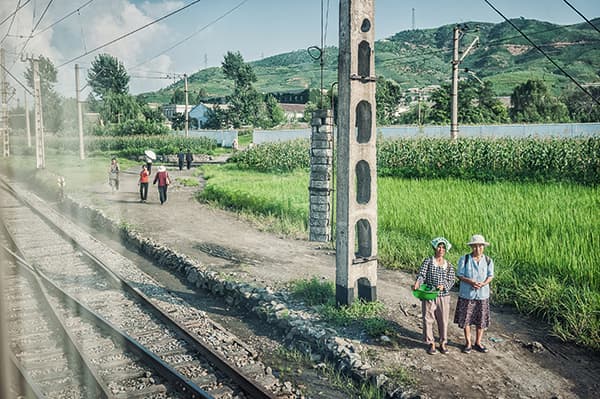
‘Juche, or self-reliance, is the ideology of North Korea,’ says Michal. ‘But the omnipresent poverty that even your guides won’t dispute makes one doubt about how self-reliant North Korea really is, especially with its dependence on international aid (which is explained to ordinary North Koreans as the spoils of war)
Getting the photos out
Then, of course, the next challenge was to get the photos out of the country without them being erased or confiscated – or for Michal to face punishment. For this, Michal varied his tactics. ‘I used many small memory cards, and they were hidden all over my rucksack,’ he says. ‘There was nothing high tech. My assumption was that, as a Polish citizen, I would be kicked out, as we are not particularly valuable as hostages. I made all my notes during the trip in Polish – and my handwriting is like a form of encryption anyway.’
Crossing the border was especially stressful, says Michal, ‘since I had taken all those dodgy photos and the guide tried to scare me into deleting them prior to setting off for the border.’
However, Michal says he had some luck. ‘Since I had left my phone in China, they ignored me; they were really interested in people’s phones. Then, someone asked if I had a camera, to which I said no. And they left me standing on my own. So I walked out of the facility trying to look bored and confident, and they never called me back. I nearly kissed the Chinese soil once we did leave.’
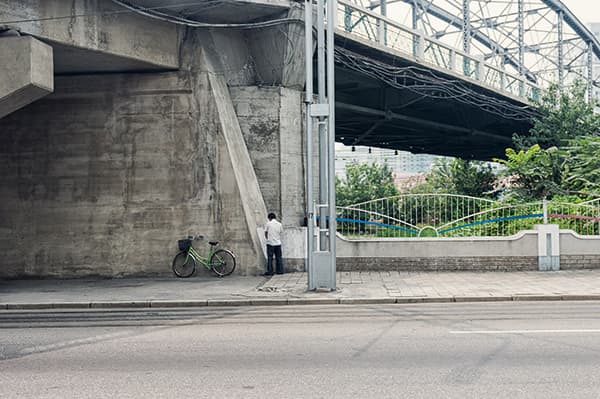
A North Korean citizen makes a quick stop
A truthful picture
Despite all the stress and risks Michal took to get (and keep) his photographs, he believes it was worth getting them out into the world. ‘We can’t deliver a complete portrait of the country, but we can try to present what shows through the cracks of the propaganda and Potemkin villages they put up for us to see,’ he says. ‘Thousands of people have written to me, thanking me for teaching them about the place.’
Describing the instant reaction to his images, it’s clear that Michal is humbled. ‘I uploaded one [photograph] online and came back to it a while later.
It had 2.5 million views and thousands of comments. I decided I would reply to everyone, so I sat in front of the screen for 14 hours. There was weeks and weeks of praise, grilling, trolling, and TV and radio interviews in several countries.’
Michal attributes the photographs going viral both to the mystery of North Korea, and because around the same time American tourist Otto Warmbier was sentenced to 15 years’ hard labour for supposedly stealing a poster from the Yanggakdo Hotel – where Michal had also stayed.
What was the reaction of the North Korean authorities once these photographs were published globally? ‘A Polish TV station tried to get a North Korean embassy employee on a show with me, but apparently the embassy refused,’ he says. ‘I don’t think I said anything particularly scandalous, nor did I expose any military secrets.’
The only real concern Michal has is for the guides who accompanied his group on the trip. ‘I hope nothing bad happened to my guides,’ he says. ‘A lot of people have expressed that concern, and it is a legitimate one, but I feel our freedom of speech is not to be compromised by any form of violence that is trying to blackmail us into self-censorship.’
Does Michal hope to return to the country one day? ‘I would be absolutely thrilled to go back once the regime collapses; before that, it would probably be unwise,’ he admits. ‘But I would love to have an honest conversation with those people and understand what they were actually thinking. Usually I don’t go back though, and I prefer going to new places; so I’m glad North Korea is off my bucket list.’
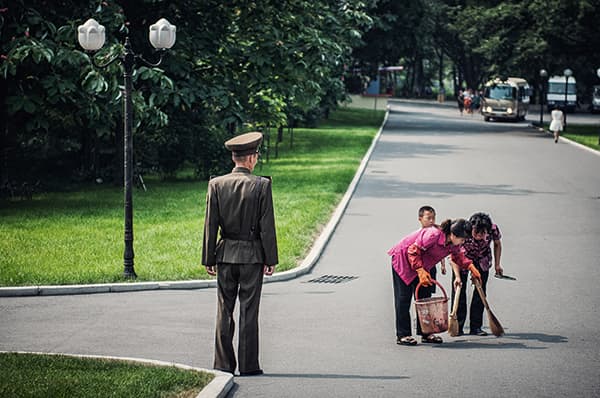
Street sweepers keep Pyongyang’s streets clean under the watchful eye of a solider
Future projects
Michal describes himself as ‘completely amateur’ and says he has no ambitions to turn professional, ‘I’m afraid going full time would kill the fun,’ he says. ‘Right now I can do whatever I want whenever I want, rather than having to follow a commercial instinct.’
There are a few more projects in the pipeline for Michal, one of which indicates he’s not about to stop taking risks .‘I’m working on a story about Mexican women who help illegal migrants,’ he says. ‘I stopped being a neutral observer, got involved and could have got human trafficking charges. I’d love to go and learn some Farsi and go to Iran, to return and tell a story. What story, I don’t yet know.’
The bare essentials

Keeping equipment to a minimum is ideal for this kind of work. ‘I use a Nikon D300S and a 24-70mm lens most of the time,’ says Michal. ‘Although I used to have an 18-200mm and 11-16mm lens, both were damaged beyond repair on a trip to a desert. I had a 50mm lens with me in North Korea, which, being significantly smaller, looks less threatening than the zoom.’
Still, that didn’t mean Michal escaped questioning at customs. ‘An officer saw my camera and the big lens attached to it,’ he says. ‘She would not let go, as if a big DSLR implied espionage; she was going through the camera and found GPS. “Ah ha!” she triumphed. In reality, all this means is I can attach a GPS unit to the camera, not that it has it built in. But good luck explaining that.
‘Laptops were fairly thoroughly searched, but if you had encrypted files, dual-boot, or anything slightly out of the ordinary, they were helpless. People generally assumed it was some sort of high-tech check, but I actually felt sorry for the computer expert they brought onto our train, and how out of touch he was with technology.’
Michal is a photographer and software developer based in London. His photography and writing have been featured in Outside Magazine, The Telegraph, Stern, Metro, The Travel Stories, Daily Mail, La Repubblica, Wyborcza.pl and many others. Visit m1key.me or his Flickr page at www.flickr.com/photos/m1key-me






